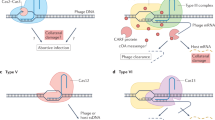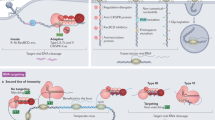Abstract
Bacterial CRISPR–Cas systems include genomic arrays of short repeats flanking foreign DNA sequences and provide adaptive immunity against viruses. Integration of foreign DNA must occur specifically to avoid damaging the genome or the CRISPR array, but surprisingly promiscuous activity occurs in vitro. Here we reconstituted full-site DNA integration and show that the Streptococcus pyogenes type II-A Cas1–Cas2 integrase maintains specificity in part through limitations on the second integration step. At non-CRISPR sites, integration stalls at the half-site intermediate, thereby enabling reaction reversal. S. pyogenes Cas1–Cas2 is highly specific for the leader-proximal repeat and recognizes the repeat's palindromic ends, thus fitting a model of independent recognition by distal Cas1 active sites. These findings suggest that DNA-insertion sites are less common than suggested by previous work, thereby preventing toxicity during CRISPR immune adaptation and maintaining host genome integrity.
This is a preview of subscription content, access via your institution
Access options
Subscribe to this journal
Receive 12 print issues and online access
$189.00 per year
only $15.75 per issue
Buy this article
- Purchase on Springer Link
- Instant access to full article PDF
Prices may be subject to local taxes which are calculated during checkout






Similar content being viewed by others
Accession codes
References
Barrangou, R. et al. CRISPR provides acquired resistance against viruses in prokaryotes. Science 315, 1709–1712 (2007).
Wright, A.V., Nuñez, J.K. & Doudna, J.A. Biology and applications of CRISPR systems: harnessing nature's toolbox for genome engineering. Cell 164, 29–44 (2016).
Sternberg, S.H., Richter, H., Charpentier, E. & Qimron, U. Adaptation in CRISPR-Cas systems. Mol. Cell 61, 797–808 (2016).
Pourcel, C., Salvignol, G. & Vergnaud, G. CRISPR elements in Yersinia pestis acquire new repeats by preferential uptake of bacteriophage DNA, and provide additional tools for evolutionary studies. Microbiology 151, 653–663 (2005).
Mojica, F.J.M., Díez-Villaseñor, C., García-Martínez, J. & Soria, E. Intervening sequences of regularly spaced prokaryotic repeats derive from foreign genetic elements. J. Mol. Evol. 60, 174–182 (2005).
Bolotin, A., Quinquis, B., Sorokin, A. & Ehrlich, S.D. Clustered regularly interspaced short palindrome repeats (CRISPRs) have spacers of extrachromosomal origin. Microbiology 151, 2551–2561 (2005).
Brouns, S.J.J. et al. Small CRISPR RNAs guide antiviral defense in prokaryotes. Science 321, 960–964 (2008).
Makarova, K.S. et al. An updated evolutionary classification of CRISPR–Cas systems. Nat. Rev. Microbiol. 13, 722–736 (2015).
Shmakov, S. et al. Discovery and functional characterization of diverse class 2 CRISPR-Cas systems. Mol. Cell 60, 385–397 (2015).
Yosef, I., Goren, M.G. & Qimron, U. Proteins and DNA elements essential for the CRISPR adaptation process in Escherichia coli. Nucleic Acids Res. 40, 5569–5576 (2012).
Nuñez, J.K., Lee, A.S.Y., Engelman, A. & Doudna, J.A. Integrase-mediated spacer acquisition during CRISPR–Cas adaptive immunity. Nature 519, 193–198 (2015).
Nuñez, J.K. et al. Cas1–Cas2 complex formation mediates spacer acquisition during CRISPR–Cas adaptive immunity. Nat. Struct. Mol. Biol. 21, 528–534 (2014).
Arslan, Z., Hermanns, V., Wurm, R., Wagner, R. & Pul, Ü. Detection and characterization of spacer integration intermediates in type I-E CRISPR-Cas system. Nucleic Acids Res. 42, 7884–7893 (2014).
Ivancic-Bace, I., Cass, S.D., Wearne, S.J. & Bolt, E.L. Different genome stability proteins underpin primed and naïve adaptation in E. coli CRISPR-Cas immunity. Nucleic Acids Res. 43, 10821–10830 (2015).
Goryshin, I.Y. & Reznikoff, W.S. Tn5 in vitro transposition. J. Biol. Chem. 273, 7367–7374 (1998).
Wang, X. & Higgins, N.P. 'Muprints' of the lac operon demonstrate physiological control over the randomness of in vivo transposition. Mol. Microbiol. 12, 665–677 (1994).
Bainton, R.J., Kubo, K.M., Feng, J.N. & Craig, N.L. Tn7 transposition: target DNA recognition is mediated by multiple Tn7-encoded proteins in a purified in vitro system. Cell 72, 931–943 (1993).
Craigie, R. & Bushman, F.D. HIV DNA integration. Cold Spring Harb. Perspect. Med. 2, a006890 (2012).
Wang, R., Li, M., Gong, L., Hu, S. & Xiang, H. DNA motifs determining the accuracy of repeat duplication during CRISPR adaptation in Haloarcula hispanica. Nucleic Acids Res. 44, 4266–4277 (2016).
Wei, Y., Chesne, M.T., Terns, R.M. & Terns, M.P. Sequences spanning the leader-repeat junction mediate CRISPR adaptation to phage in Streptococcus thermophilus. Nucleic Acids Res. 43, 1749–1758 (2015).
Rollie, C., Schneider, S., Brinkmann, A.S., Bolt, E.L. & White, M.F. Intrinsic sequence specificity of the Cas1 integrase directs new spacer acquisition. eLife 4, e08716 (2015).
Nuñez, J.K., Bai, L., Harrington, L.B., Hinder, T.L. & Doudna, J.A. CRISPR immunological memory requires a host factor for specificity. Mol. Cell 62, 824–833 (2016).
Heler, R. et al. Cas9 specifies functional viral targets during CRISPR–Cas adaptation. Nature 519, 199–202 (2015).
Wei, Y., Terns, R.M. & Terns, M.P. Cas9 function and host genome sampling in Type II-A CRISPR-Cas adaptation. Genes Dev. 29, 356–361 (2015).
Arslan, Z. et al. Double-strand DNA end-binding and sliding of the toroidal CRISPR-associated protein Csn2. Nucleic Acids Res. 41, 6347–6359 (2013).
Ka, D. et al. Crystal structure of Streptococcus pyogenes Cas1 and its interaction with Csn2 in the type II CRISPR-Cas system. Structure 24, 70–79 (2015).
Nuñez, J.K., Harrington, L.B., Kranzusch, P.J., Engelman, A.N. & Doudna, J.A. Foreign DNA capture during CRISPR–Cas adaptive immunity. Nature 527, 535–538 (2015).
Wang, J. et al. Structural and mechanistic basis of PAM-dependent spacer acquisition in CRISPR-Cas systems. Cell 163, 840–853 (2015).
Yosef, I. et al. DNA motifs determining the efficiency of adaptation into the Escherichia coli CRISPR array. Proc. Natl. Acad. Sci. USA 110, 14396–14401 (2013).
Pingoud, A. & Jeltsch, A. Structure and function of type II restriction endonucleases. Nucleic Acids Res. 29, 3705–3727 (2001).
Plagens, A., Richter, H., Charpentier, E. & Randau, L. DNA and RNA interference mechanisms by CRISPR-Cas surveillance complexes. FEMS Microbiol. Rev. 39, 442–463 (2015).
Deltcheva, E. et al. CRISPR RNA maturation by trans-encoded small RNA and host factor RNase III. Nature 471, 602–607 (2011).
Krupovic, M., Makarova, K.S., Forterre, P., Prangishvili, D. & Koonin, E.V. Casposons: a new superfamily of self-synthesizing DNA transposons at the origin of prokaryotic CRISPR-Cas immunity. BMC Biol. 12, 36 (2014).
Hickman, A.B. & Dyda, F. The casposon-encoded Cas1 protein from Aciduliprofundum boonei is a DNA integrase that generates target site duplications. Nucleic Acids Res. 43, 10576–10587 (2015).
Hemsley, A., Arnheim, N., Toney, M.D., Cortopassi, G. & Galas, D.J. A simple method for site-directed mutagenesis using the polymerase chain reaction. Nucleic Acids Res. 17, 6545–6551 (1989).
Martin, M. Cutadapt removes adapter sequences from high-throughput sequencing reads. EMBnet.journal 17, 10–12 (2015).
Langmead, B., Trapnell, C., Pop, M. & Salzberg, S.L. Ultrafast and memory-efficient alignment of short DNA sequences to the human genome. Genome Biol. 10, R25 (2009).
Crooks, G.E., Hon, G., Chandonia, J.-M. & Brenner, S.E. WebLogo: a sequence logo generator. Genome Res. 14, 1188–1190 (2004).
Robinson, J.T. et al. Integrative genomics viewer. Nat. Biotechnol. 29, 24–26 (2011).
Thorvaldsdóttir, H., Robinson, J.T. & Mesirov, J.P. Integrative Genomics Viewer (IGV): high-performance genomics data visualization and exploration. Brief. Bioinform. 14, 178–192 (2013).
Acknowledgements
We are grateful to J.K. Nuñez for technical assistance and members of the Doudna laboratory for discussion and input on the manuscript. This project was funded by US National Science Foundation grant no. 1244557 (J.A.D.) and National Institute of General Medicine Sciences grant no. 1P50GM102706-01 (J.H. Cate). A.V.W. is supported by a US National Science Foundation Graduate Fellowship. J.A.D. is supported as an Investigator of the Howard Hughes Medical Institute and as a Paul Allen Distinguished Investigator. This work used the Vincent J. Coates Genomics Sequencing Laboratory at UC Berkeley, supported by NIH S10 Instrumentation Grants S10RR029668 and S10RR027303.
Author information
Authors and Affiliations
Contributions
A.V.W. performed experiments. A.V.W. and J.A.D. designed experiments, analyzed data, and wrote the manuscript.
Corresponding author
Ethics declarations
Competing interests
J.A.D. has filed a related patent with the United States Patent and Trademark Office. J.A.D. is a cofounder and Scientific Advisory Board member of Caribou Biosciences and Intellia Therapeutics and a cofounder of Editas Medicine, all of which develop CRISPR-based technologies.
Integrated supplementary information
Supplementary Figure 1 High-throughput sequencing of SpyCas1–Cas2 integration shows preference for leader-proximal repeats.
(a-f) Mapped reads from the integration reaction into pUC19 (a,b), pEcoCR (c,d), and pSpyCR (e,f). Plasmid features are shown below pile-up.
Supplementary Figure 2 SpyCas1–Cas2 requires divalent cations and 3′-OH for integration.
(a) Integration with radiolabeled protospacer and divalent cations. (b) Integration with protospacers lacking a 3′ nucleophile. 3′ deoxy strands are noted as “H”, and the labeled strand is indicated with an asterisk. Uncropped gels are shown in Supplementary Data Set 1.
Supplementary Figure 3 4-nt overhangs allow for more rapid integration.
(a) Integration assay with labeled target and protospacers with 3′ overhangs. Uncropped gel is shown in Supplementary Data Set 1. (b,c) Quantification of leader-side and spacer-side integration in (a). Source data is available online.
Supplementary Figure 4 Single-nucleotide mutations have minor effects on integration.
(a-c) Integration assays using targets with single-nucleotide transversions (C→G, A→T) at the indicated position in the leader (a), leader-proximal repeat (b), and spacer-proximal repeat (c). The WT target sequence is shown below for reference. Uncropped gels are shown in Supplementary Data Set 1.
Supplementary Figure 5 Full-site integration requires proper-length substrates.
(a) Integration assay with hairpin target and radiolabeled variable-length protospacer. Product bands are indicated. (b) Integration assay with variable-length hairpin target and radiolabeled protospacer. Product bands are indicated. Uncropped gels are shown in Supplementary Data Set 1.
Supplementary Figure 6 Wild-type leader-side and spacer-side half sites both support full-site integration.
(a) Quantification of disintegration reaction shown in Figure 5b,c. Reaction was performed in triplicate. Means are plotted, with error bars representing standard deviation. (b) Disintegration and full-site integration assay with 3′ deoxy leader fragment and labeled protospacer strands on leader-side WT half-site. (c,d) Disintegration assays with wild-type (WT) and off-target (OT) spacer-side half-site substrates with labeled spacer fragment (c) and labeled integrated protospacer strand (d). (e,f) Full-site integration assays with spacer-side half site with labeled plus strand (e) and labeled unintegrated protospacer (f). (g) Disintegration and full-site integration assay with 3′ deoxy spacer fragment and labeled protospacer strands on spacer-side half-site.
Supplementary information
Supplementary Text and Figures
Supplementary Figures 1–6 and Supplementary Tables 1 and 2 (PDF 697 kb)
Supplementary Data Set 1
Uncropped gels (PDF 14718 kb)
Rights and permissions
About this article
Cite this article
Wright, A., Doudna, J. Protecting genome integrity during CRISPR immune adaptation. Nat Struct Mol Biol 23, 876–883 (2016). https://doi.org/10.1038/nsmb.3289
Received:
Accepted:
Published:
Issue Date:
DOI: https://doi.org/10.1038/nsmb.3289
This article is cited by
-
Histones direct site-specific CRISPR spacer acquisition in model archaeon
Nature Microbiology (2023)
-
Mechanism for Cas4-assisted directional spacer acquisition in CRISPR–Cas
Nature (2021)
-
Prophage integration into CRISPR loci enables evasion of antiviral immunity in Streptococcus pyogenes
Nature Microbiology (2021)
-
Real-time observation of CRISPR spacer acquisition by Cas1–Cas2 integrase
Nature Structural & Molecular Biology (2020)
-
Molecular mechanisms of CRISPR–Cas spacer acquisition
Nature Reviews Microbiology (2019)



